Australian Education Award Finalist - Learnership Case Study
It has been my pleasure and privilege to collaborate with teachers and leaders at Asquith Girls High School (AGHS) in Sydney since 2019. Together we have created a powerful and innovative program to nurture growth mindsets and develop learnership in their 650 students. And I am absolutely thrilled that Asquith Girls High School has been recognised as a finalist in the 2022 Australian Education Awards for best student wellbeing program.
Known in the school as AIM (Asquith Individualised Mentoring) the program pairs each learner with a teacher mentor to support them in creating and articulating their learning goals. The program draws on my work to nurture a growth mindset, build learnership capabilities and develop the Habits of Mind in students. I have provided staff with ongoing professional learning and the structures and resources to help them effectively implement these ideas in every classroom, every day.
The school has done an amazing job of pursuing its vision for creating a culture of aspiration, agility and agency where all students are known, valued and cared for. It continues to be a pleasure to have the opportunity to weave my work into this program, and to work with such a passionate group of educators to realise their overall vision.
There have been many people involved in envisaging and creating the AIM program. Special credit must go to Principal Elizabeth Amvrazis and her leadership team for their ongoing commitment to the program. My role in the AIM program has been to partner with the school to:
1. Provide extensive and sustained professional learning to teachers and school leaders in the areas of growth mindset, learnership and Habits of Mind.
2. Provide the support, structures, scope and sequence and resources to ensure the work is sustained, and continues to grow and be embedded into the culture of the school.
While the AIM program is unique to Asquith Girls High School, the key ideas of Growth Mindset, Learnership and Habits of Mind are relevant is every school. I outline below how we implemented this successful cultural change program, and describe some of the positive results we’ve seen so far. If you’re interested in applying this work in your own school, please feel free to contact me to discuss how.
How We Nurtured A Growth Mindset
What is a growth mindset? Stanford University psychologist, Carol Dweck’s work in growth mindset states that people believe that their abilities can be developed through dedication and hard work. The benefits of a growth mindset include being more persistent, more likely to take on challenges and valuing effort more highly. In pursuit of these qualities, many schools have attempted to implement growth mindset programs. Unfortunately, most schools have seen little, if any, impact from these programs.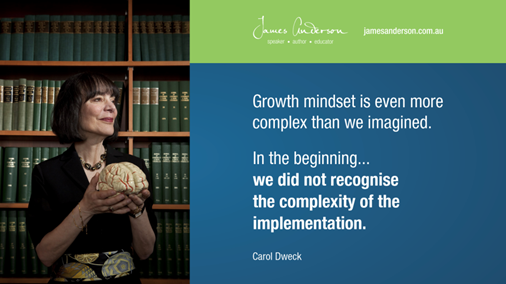
While the benefits of a growth mindset are clear, it turns out that successfully implementing programs that change students’ mindsets are rare. Programs that put posters on walls, and use catchphrases like "not yet" simply don’t work. In Carol Dweck’s own words, "growth mindsets are even more complex than we imagined. In the beginning we did not recognise the complexity of implementation".
"However, the AIM program is accomplishing what other programs have struggled to do – successfully implement an effective growth mindset approach within Asquith Girls High School."
To do this, we first took the approach that successful growth mindset interventions begin not with students, but with teachers. Even well-intentioned teachers can unintentionally create fixed mindset messages in their classrooms. This is what Carol Dweck and Melbourne-based researcher Susan Mackay have identified as the false mindset (i.e., saying you have a growth mindset – or a growth mindset approach – when you don’t really have it or perhaps understand what it is). So it is critical to give teachers the opportunity to reflect deeply on their own mindsets.
To provide teachers with this opportunity I led extensive professional learning designed to challenge teachers’ mindsets, and to help them recognise how their day-to-day interactions – the words they use, the structures they establish, the assessment they use and more – contribute to the development of either fixed or growth mindsets in students. We also developed a school-wide Growth Mindset Style Guide to help teachers change their messaging and fill their classroom with growth messages.
The Growth Mindset Style Guide provides teachers with a collection of clear and easily adopted "nudges". These simple strategies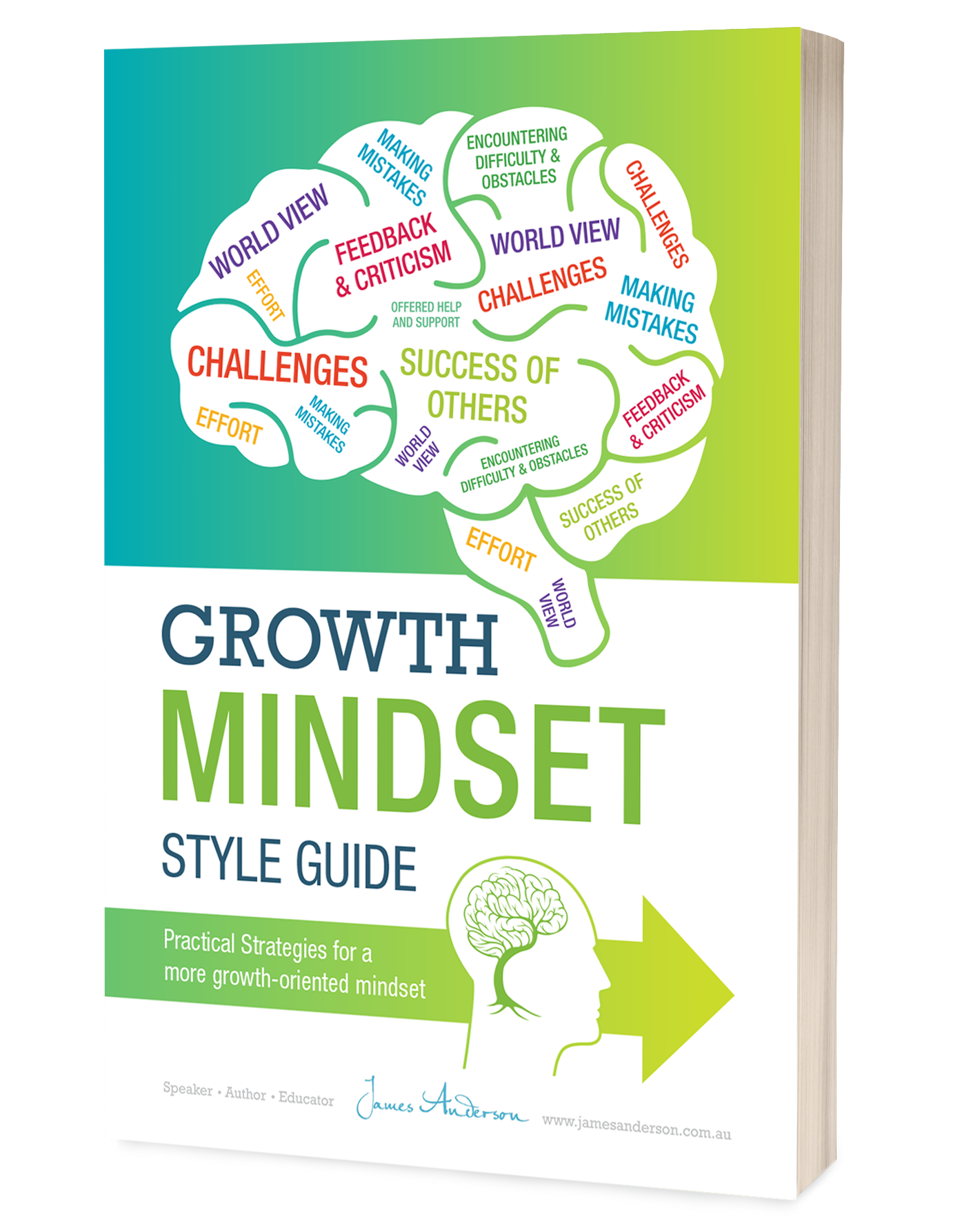 address the false mindset and help to guide teachers’ actions and decisions so they are more likely to create growth messages in their classrooms.
address the false mindset and help to guide teachers’ actions and decisions so they are more likely to create growth messages in their classrooms.
A key insight in AGHS’s growth mindset implementation was to recognise the mindset continuum. Looking at the dichotomy of fixed versus growth mindsets works well to understand the importance of a growth mindset.
However, seeing mindset as a continuum between fixed and growth helps us better understand how to change students’ mindsets.
In Dweck’s words, "a growth mindset is not a declaration, it’s a journey", and it is a journey along the mindset continuum.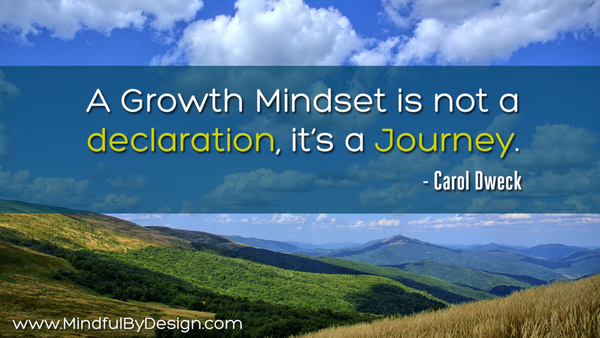
The AIM program focuses on teaching for a growth mindset, rather than about a growth mindset. By combining our understanding of mindset as a continuum, and how to fill classrooms with more growth messages, the teachers at Asquith Girls High School have been able to nurture a more growth-oriented mindset in their students.
Measureable Results
The success of the AIM program in developing a growth mindset in students is easily seen through changes in student behaviour. According to data gathered by the school through the "Tell Them From Me survey" (a wellbeing and learning tool used widely in NSW public schools) the number of students who are setting more challenging goals as a result of the growth mindset approach has increased by 12.5%. And despite all of the challenges presented by COVID and remote learning, the number of students displaying high levels of perseverance has increased 30%. At the same time teacher expectation for success – the degree to which teachers hold high expectations for students - rose by 8.5%
How We Increased Learnership
Setting challenging goals and having high levels of persistence is not enough, however, unless students also understand how to go on and achieve those goals! A significant goal of the AIM program is to ensure students not only understand that they are capable of growth (a growth mindset), but also understand how to go about achieving it. This is where my work in developing learnership has become a central feature of the AIM Program.
Learnership is a concept I have developed to describe the skill of learning. Like all skills it is developed over time, through the deliberate use of practice and dedicated strategies. It is an improvement in the ability to learn. And it results in the learner gaining more from every learning opportunity every day. It is about getting better at getting better.
Learnership begins by describing six different types of learners categorised based on how they respond to challenge, develop their Habits of Mind, gather information through mistakes and feedback and use their time and energy.
My Learnership Diagnostic is an online tool specifically designed to assess and identify the prevalence of behaviours associated with each type of learner. It provides insights into the types of learners teachers are working with, allowing them to better target their instruction. The tool provides information on individual learners, and can provide aggregates for cohorts of learners or even provide a whole school overview. Importantly, it also provides a mechanism to track improvement in student learnership over time.
A key goal of the AIM Program is to develop agile learners. An agile learner is defined by their ability to embrace challenges, cultivate their Habits of Mind, design mistakes, tailor feedback and invest more of their time and energy into growth. Agile learners achieve more, both academically and in life. Utilising the resources and learning design in the AIM Portal described below, the AIM program specifically coaches students in these key areas to improve how they engage in the learning process for better outcomes.
Importantly agile learners surpass "resilience" to become anti-fragile by leveraging their challenges to help them grow at every opportunity. By focusing on growth they are proactively future proofing themselves by preparing themselves for the future. The result is that they don’t merely survive in our volatile, uncertain and complex world, but thrive in it.
How We Developed Habits of Mind
The Habits of Mind form a central part of the AIM program. Identified by Art Costa and Bena Kallick the Habits of Mind describe the dispositions of excellent problem solvers. These are the dispositions that are skilfully and mindfully employed by successful people when confronted with problems without obvious solutions.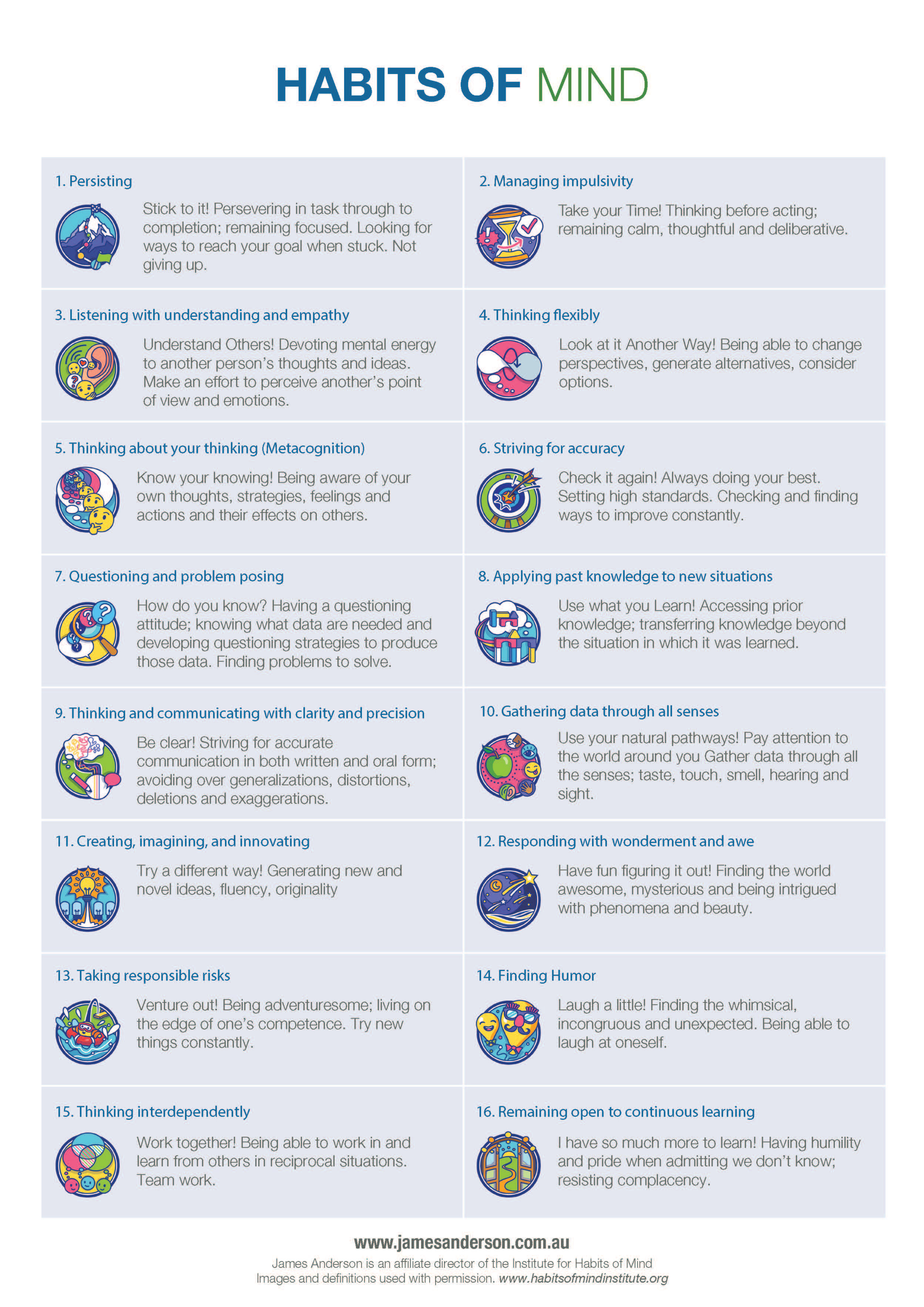
With more than 20 years’ experience working with Habits of Mind, I worked with AGHS to develop professional learning and resources to support their work with Habits of Mind (HOM). The HOM provide a common language for learning in the school, that is shared across the school community, including among students, teachers and parents. Beyond being just a language for learning, HOM allow the school community to share a common focus on how students are learning, not just what they are learning.
Like all elements of the AIM program, the Habits of Mind form part of the day-to-day work in the classroom. The faculty has had significant training in infusing the Habits of Mind as explicit learning outcomes into unit planning. Drawing on the model provided in Understanding by Design, written by Grant Wiggins and Jay McTighe, the faculty were able to explicitly weave the development of the Habits of Mind into unit planning, creating rich tasks that were designed to assess students’ deep understanding of the subject areas, and foster their mature application of the Habits of Mind.
An important and unique feature of AGHS’s work with Habits of Mind is the Habits of Mind Profile Tool. This powerful new tool provides a unique way of assessing a student’s Habits of Mind. It provides a snapshot of the student’s current level of development and gives insight and direction to guide future growth. The creative way the tool can compare a student’s Habits of Mind to the demands of the rich tasks set for them in each learning unit, allows teachers to provide individualised Habits of Mind profiles and identify individually targeted learning plans for each student.
The AIM Portal - where the magic happens!
The AIM Portal is the centrepiece of the AIM program and critical to its success. For sustained cultural change to occur it is essential that any program be woven into the bigger life and vision of the school. Standalone programs rarely stand the test of time. Too many schools have experienced the slow decay of programs as priorities shift, commitments waver, learning is forgotten and staff and leadership change over time. Not to mention the immediate pressures teachers experience when delivering the curriculum every day which can force other priorities into the background.
The AIM Portal is specifically designed to address these challenges. It provides the structures, resources and professional learning to support, sustain and nourish the AIM program over time. The structure provides a mechanism for teachers to revisit, refresh and recommit to the ideals of the AIM program throughout each term.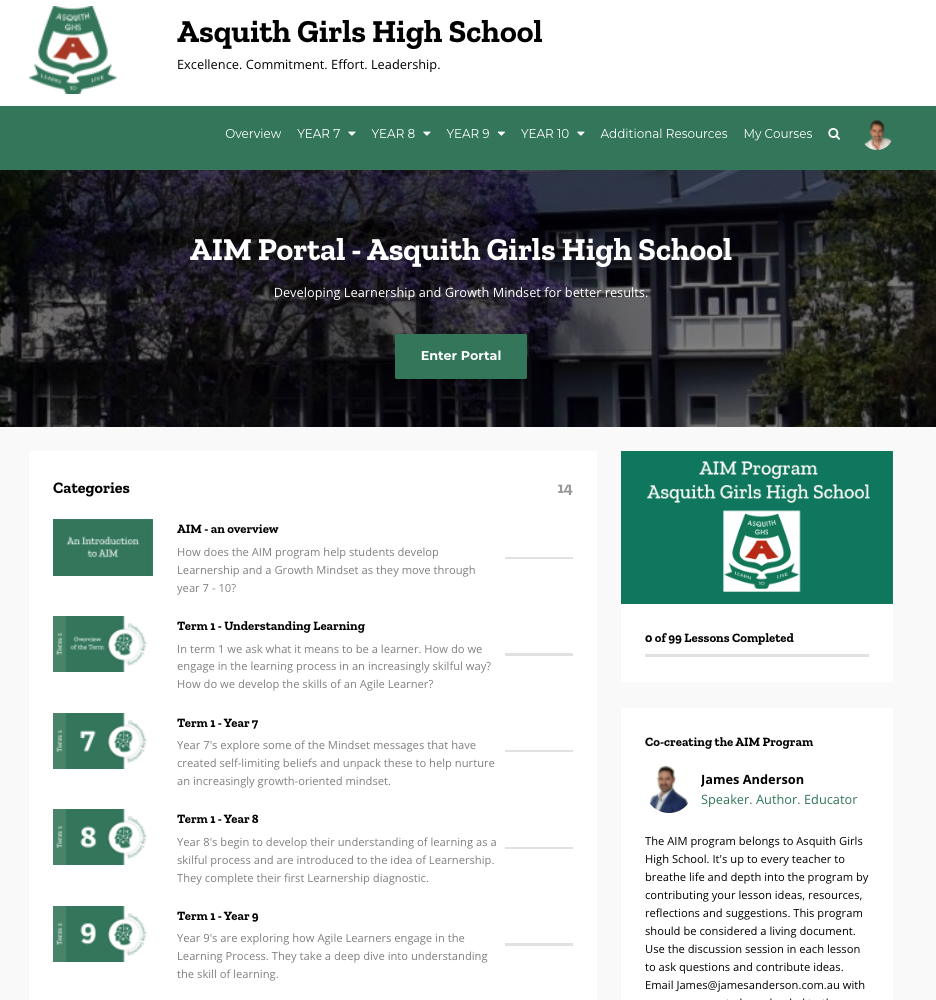
AGHS has committed to every student having two to three AIM program lessons each term as part of the school time table. It is these lessons that provide the regular opportunity for students to explore key ideas related to growth mindset, learnership and Habits of Mind. These lessons further provide the regular impetus for teachers to continue their professional learning, and the ongoing infusion of growth mindset, learnership and Habits of Mind into classroom practice.
The AIM Portal is directly linked to these lessons. It provides the structure of the AIM program in the form of a scope and sequence of lessons for the entire AIM program (over 50 lessons), as well as all the resources required to deliver the learning. The structure of each lesson in the portal provides ongoing professional learning, student activities and teacher actions to integrate and infuse the key ideas into every lesson.
Scope and Sequence for Learnership
Rather than being a collection of ideas that are left to teacher discretion to implement, the AIM program is carefully structured to provide a sustained and sequenced approach to nurturing a growth mindset, improving learnership and developing Habits of Mind.
A theme is adopted for each school term that provides a shared focus and common experience for all students and teachers at every year level throughout the school. As teachers move between year levels they can be confident they are familiar with the general focus of the AIM program the students are experiencing that term.
The focus for each term is:
Term 1 – Understanding Learning: a focus on mindset and becoming a skilful learner
Term 2 – Habits of Mind: Building a shared language of learning and creating and using your Habits of Mind profile to guide development
Term 3 – Challenges: understanding the nature of challenges and becoming comfortable with the discomfort of being in your learning zone
Term 4 – Achieving Growth: investing time and energy in growth. Changing the meaning of assessment
In a similar way, the focus and complexity of each year level increases each year to target age-appropriate strategies to ensure students become increasingly skilful, agile learners who have agency in the world. The focus for each year level is:
Year 7: We are Learners. Students focus on understanding themselves as learners, recognising how they engage in the learning process, building a deep understanding of learning as a skill and developing a language for learning through the Habits of Mind.
Year 8: Becoming Skilful Learners. Students focus on developing how they engage in the learning process. They build their first Habits of Mind profile to give insights into their development. They become increasingly familiar with their learning zone and their relationship with it, as they learn to become comfortable with the discomfort of stretch, challenge and effort.
Year 9: Taking Charge of Learning. Students are becoming increasingly self-directed learners. They are taking charge of the development of their Habits of Mind, setting challenging goals and recognising how they are developing as skilful learners.
Year 10: Becoming Agile Learners. Students are now very aware of how they engage in the learning process and are actively developing the skills of an agile learner.
The resulting experience for students is a four-year program that spirals through key elements of nurturing a growth mindset and developing learnership. A familiar pattern is followed each year, with the complexity of the ideas and strategies increasing year upon year.
AIM Lessons
Each lesson in the AIM Portal consists of three elements:
1. Professional learning related to key concepts being covered.
2. Student activities to explore and develop skilful learning with students.
3. Teacher actions with insights and pedagogy for teachers to implement in day-to-day teaching practice.
The AIM Portal provides all the resources required, both for teachers that are delivering AIM lessons, and for others who may simply need to be aware of the topic so it can be referenced in regular classroom teaching.
Ongoing "Just In Time" Professional Learning
While the initial intensive professional learning was provided, the AIM Portal provides short video lessons (five to 20 minutes in length) focused on the topic being addressed in the AIM lesson. This "Just in Time" professional learning revisits key ideas, gives appropriate examples and gives teachers the opportunity to regularly refresh their learning.
These regular professional learning videos are excellent reminders for staff who have experienced the whole school professional learning. They are also a wonderful way to support new staff to the school and by "drip feeding" professional learning in the areas of growth mindset, learnership and Habits of Mind it keeps the ideas front of mind for teachers and administration.
If you’d like to learn more about Learnership Professional Learning Opportunities click here to read more and access upcoming events.
The AIM Portal provides the professional learning and support required to successfully deliver this rich and extensive program.
Student Activities
The student activities section of the AIM lesson is not prescriptive. Rather, it provides teachers with the key learning outcomes expected to be achieved in that lesson, including questions for class discussion and suggested classroom activities. A wide range of supporting resources are also provided. In this way teachers are supported in designing lessons that are suited to the individual needs of their students.
The AIM Portal also provides an opportunity for teachers to share their experiences teaching the lesson. In this way the AIM portal is a living document where strategies, approaches and resources that prove useful can be collected and reused over time.
Teacher Action
One of the biggest challenges for any professional learning is how to apply the theory in classroom practice. The Teacher Action section of the AIM lesson provides immediate, relevant and detailed instruction on how to apply the key ideas around growth mindset, learnership and Habits of Mind, into classroom practice. This ensures that students’ AIM lesson experiences are immediately relevant in the classroom.
How You Can Develop Learnership In Your School
The AIM program and the AIM Portal are the result of more than three years of focused, sustained work by Asquith Girls High School. It’s recognition as a Finalist in the Australia Education Awards is a testament to the depth, rigour and quality of the program.
While the AIM program is uniquely woven into Asquith Girls High School, the key ideas of nurturing a growth mindset, improving learnership and developing students’ Habits of Mind to improve student learning outcomes are applicable in every school.
The AIM Portal is highly transferable and provides the professional learning, scope and sequence, structures and resources necessary to implement and sustain this important work in any school environment.
If you’d like to find out more about how you can quickly implement a similar program in your school, please contact James directly via email or book a time in his calendar using these links.
Best Wishes,
Stay connected with news and updates!
Join my mailing list to receive the latest news and updates about mindset, Habits of Mind, Learning Agility and more.
